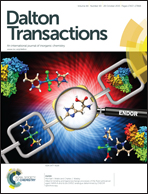An amphidynamic inorganic–organic hybrid crystal of bromoplumbate with 1,5-bis(1-methylimidazolium)pentane exhibiting multi-functionality of a dielectric anomaly and temperature-dependent dual band emissions†
Abstract
Organic–inorganic hybrid crystals, [1,5-bis(1-methylimidazolium)pentane][PbBr3]2 (1), were achieved through the mutual diffusion of a bi-imidazolium based ionic liquid and PbBr2 solution of DMF in a glass tube. The hybrid solid crystallizes in the orthorhombic space group Fdd2 at room temperature; and is composed of one-dimensional [PbBr3]∞ chains where the neighbouring PbBr6 coordination octahedra are linked together via the face-sharing mode and the inorganic chains are surrounded by organic cations. The hybrid solid exhibits a dielectric anomaly around 443 K and dielectric relaxation above 400 K, the dielectric response mechanism was investigated using variable-temperature X-ray single crystal and powder diffraction as well as DSC techniques. Fascinatingly, this hybrid solid shows dual band emissions, moreover, the fluorescence nature of the two emission bands exhibits a distinct response to temperature, leading to a temperature-dependent fluorescence color, this feature has promising application in the emission temperature-sensing field.


 Please wait while we load your content...
Please wait while we load your content...